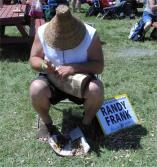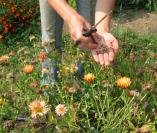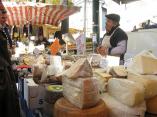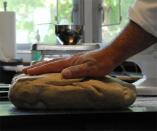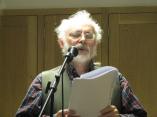Breakfast on the road. Only at the best eateries in Italy? Surprised us all by having what might be the best croissants we’d ever tasted.
Unfortunately good taste did not extend to their selection of Hitler beer and dictator wines…
We arrived in Torino ready for our day of coffee at the Lavazza Training Centre, and sure enough we were coaxed into our seats after lashings of freshly made Lavazza espresso. After a morning learning about the ins and outs of Italian coffee production and marketing, and a bit of the bean’s history and geography, we went for a tasting session of a dozen different coffees, both robusta and arabica varieties.
There was a dramatic difference between all of them, tasted side by side like that. Under the natty tutelage of the company’s Golden Palate, we learned the sniff ‘n slurp method of coffee tasting, and heard about the differences between wet and dry processing: washed and unwashed beans, and the various ways of preparing them for roasting. We got a whole new tasting vocabulary, learning new defects like quakery, grassy, woody and fermented.
Lavazza has the biggest roasting operation in Italy and the lion’s share of the domestic market, and so it’s important to keep pressing forward to stay ahead of the competitors (…can I resist saying: in the poisonous growth economy we find ourselves in?) and we heard about a few of the new product lines, which ranged from worthy to silly. Many of them were spawned (and as you will shortly see I use the word advisedly) through the company’s partnership with Spanish foam-meister, chef Ferran Adria.
Here we see the Coffeesphere, a bit of complicated nonsense to create a hit of sweet, gooey coffee substance that has the shape and texture of a soft-boiled egg yolk.
And syringes, perforated plexiglass slabs and a snappy lab coat are required to make the same thing, only smaller, so they can call it coffee caviare.
There was also a sweet, sticky foam coffee that came out of a nitrogen canister, like the ones restaurants use for whipped cream, making something called Espesso that, being foam, is the coffee that doesn’t spill. They’ve even designed a special coffee spoon with a hole in the middle as if to prove to skeptics that it really isn’t a liquid anymore. Well, maybe in a market that finds Italian television watchable it could work, I don’t know.
And this miracle of twentieth century necessity: your very own tube of UHT milk foam for those moments of crisis when you must have spuma (foamed milk) now now now. If that’s the sort of thing that amuses you, you might want to invest in a special plastic cup with a divider in the middle to drink it from. I guess what I found most disturbing about the innovation section was the amount of packaging and plastic and all round waste it was generating for the sake of stimulating a saturated market. We’re a long way from a simple coffee bean here.
The company has other promotional devices, like their vamped up girlie calendar (shades of Italian television with its partially dressed presenters) that made me feel less and less Italian by the minute. But produces some excellent print publications. And there’s its worthy sustainability project, Tierra, which lets the company pump a bit of money and development aid back into coffee-growing economies. Long may that project last.
We finished our day with a tour of the highly automated factory, dodging unmanned forklifts and miles of conveyor belts, and pondered the acres of warehouse with its robotic shelf-stockers gliding silently up and down the towers of packaged coffee, reading bar codes and pulling pallets out and putting pallets in. Surreal and strange and not a little overwhelming.
And then we were turned out for a free hour or so in the hot streets of Torino – everything having just shut for the evening – until it was time for supper at Pizzeria Le Rondini, with its decidedly, and thankfully, manual production methods.
Many of us had the house specialty, which had a thick, chewy crust filled with fresh ricotta, and topped with buffalo mozzarella, fresh tomatoes and salami.
We dined with Piero Rondolino, owner of Tenuta Colombara, a farm which produces the estimable Acquerello Rice, whose business we sadly didn’t get to visit. He grows the prestige risotto rice variety, Carnaroli, and ages it to give it better flavour and texture. It’s an organic business, and he uses a number of creative methods to manage it; he told us about the dragonflies they introduce to the fields to eat the mosquitoes that breed there.
After supper, a few of us slipped away to bide our time in the neverending summer evening queue at Grom‘s mother ship.

